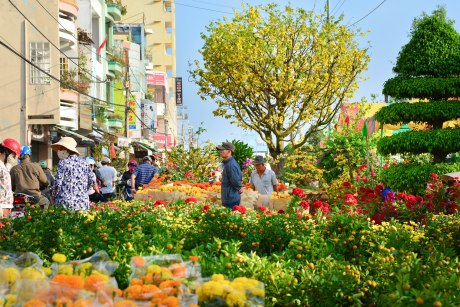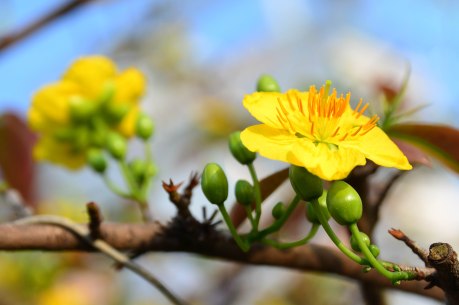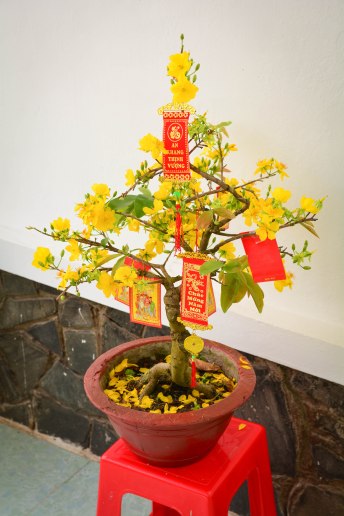You won’t hear many guys admit to being a lover of flowers. Those kinds of things are generally reserved for appreciation by girlfriends, wives and mothers. Spurred on by the constant struggle for equality and inspired by the all encompassing presence of them in Vietnam, I’m actually starting to appreciate flowers much more than I ever have.

Perhaps it’s my older age or my oppressed femininity trying to come but no matter how much my interest grows in flowers it’ll always be dwarfed by the Vietnamese people’s absolute obsession for them. This adoration is particularly strong around Lunar New Year (Tet Holiday) in Vietnam.
Tet is a time for most to return from work in the hectic cities and back to their homes throughout the boundless countryside or regional cities. The main celebration of the new years last for four days and are spent visiting loved ones, eating tonnes of delicious food (offering a little to ancestors), singing karaoke, sleeping and starting the year with a jubilant and positive mind full of goodwill towards others.
Back to the flowers and the Hoa Mai is one particular blossom whose captivating petals receive way more attention than all the others combined – especially so at this time of year.
Often referred to as an Apricot Blossom in English it belongs to the Forsythia family and is a native of East Asia. There are over a dozen varieties of Forsythia found in both Korea and China (and a random one over in Europe). The most well-known is Japan’s cherry blossom which comes out at springtime to attract thousands of people from around the world to it’s shores.
Two common varieties of Forsythia are found in Vietnam. “Hoa Dao” (Peach Blossom) is pink in colour and represents good fortune. It’s more suitable to northern Vietnam weather conditions and therefore it’s favoured by people in Hanoi. In the warmer climate of southern Vietnam the bright yellow Hoa Mai (Apricot Blossom) is much more common. In cliche Asian symbolism it also represents prosperity and wealth.
Before Lunar New Year each household usually buys one small tree or a large branch that when cared for in the final days of winter, will magnificently bloom for the start of spring and bring good luck to the house and all it’s dwellers. A lot of people are lucky enough to have their own healthy Hoa Mai bush at home from past years which is carefully pruned in the weeks leading up to Tet so it blooms at just the right time.
It’s not so much the luscious golden petals and flashy orange anthers that make this plant so curious but the hundreds on cute unopened buds that patiently wait….
…stretch…
…and slowly open over the course of a day…
…till suddenly they…
… POP!

Opening up they reveal a cluster of orange anthers surrounded by thin and delicate petals that seem to hang on for the next day or two until they tumble to the floor with smallest gust of wind or brush of an elbow. This is where you must be careful and treat them gently. Plants should not be moved too much in the first few days of the year and flowers shouldn’t be disturbed. Their beauty should be carefully retained. The plant itself represents good luck and wealth for the coming year and if they lose a lot of petals over the first few days of Tet, it can be seen as bad luck for the coming year.
An interesting fact I stumbled onto was that while the traditional Hoa Mai flower has only five petals though these day hybrids are more common and these newer varieties can have up to eight. More petals means more luck!? Left to their own devices the trees will grow back their leaves and will show less flowers for the remainder of the year until a few weeks before spring begins again and the process begins again.
The Hoa Mai is a joyful, elegant and marvellous flower for so many Vietnamese and foreigners alike.
The Hoa Mai is Tet.




